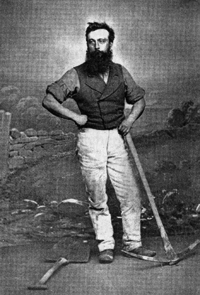
THE VILLAGE
History of Crocketford
Crocketford, or Nine Mile Bar as the village is also known, is midway - 9 miles - between Dumfries and Castle Douglas. The history of the village goes back many years, but it did not really exist as a village before the arrival, in 1787, of the strange sect known as the Buchanites. Prior to that, it was simply a meeting of drove roads, some coming down from Ayr and Girvan and some from Portpatrick and beyond. In these early days, the only roads were tracks created and used by cattle, pigs and sheep being driven to market, or by the occasional rider on horseback - sometimes, smugglers looking for a quick and easy way to their hideouts in the hills, safe from the excise men such as Rabbie Burns, our celebrated National Bard, who lived in Dumfriesshire for the last eight years of his life.
The Buchanites, an 18th-century religious sect founded in Ayrshire, were followers of Elspeth Buchan who claimed to be a prophet and Biblical figure named in the Book of Revelation. As with many controversial religious sects existing at the time, the Buchanites were increasingly disapproved of by mainstream society and, following death threats, they fled Irvine, North Ayrshire and settled in Closeburn, near Dumfries, in 1784. By 1787, they were again expelled from Dumfriesshire and settled in what it is now Crocketford.
Despite her claims to immortality, Elspeth Buchan died of natural causes in 1791 and the sect formally came to an end when its last adherant, Andrew Innes, also died in the Buchanites’ last abode, ‘Newhouse’ in Crocketford, in 1846. Newhouse still stands today. Many Buchanites were buried (or reburied) in a graveyard next to the north-west wall of Newhouse, in the expectation that they would ‘ascend’ to Heaven with Elspeth Buchan.
About the Anderson Memorial Hall
It hasn't been possible so far to find an exact date for the building of the Hall, but Rev. David Frew, writing in 1909 in his History of the Parish of Urr, states that, in Crocketford, “The condition of things, as it appeared in 1825, was prosperous and thriving”.
He also states that, “though not possessed of a church of its own, Crocketford has not been without a fairly regular supply of religious ordinances, a preaching station upon undenominational lines having been established in the village school, so far back as 1839”.
The school, which had been built thanks to the generosity of a local landowner and benefactor, remained in use until 1912 when a new one was built and, in 1922, according to an article in The Weekly Scotsman, Mr. W. J. Hay, John Knox’s House, Edinburgh, states, “Lovers of ‘Bairnies Cuddle Doon’ and the other delightful poems of Alexander Anderson, as well as those who had the privilege of meeting him during his lifetime, will be glad to learn that the old schoolhouse in Crocketford which he attended as a boy has been purchased for the purpose of providing a public hall for the villagers".
"Acting on a suggestion of mine, the Trustees have decided to make the building a Memorial of its quondam pupil, who worked his way from its simple teachings to be acting librarian at the University of Edinburgh.”

Crocketford Millennium Booklet
To mark the new millennium in the year 2000, Committee members got together to produce a booklet outlining the history of the village. This booklet contains interesting facts and local anecdotes.
Download Millennium Booklet
Follow us
Crocketford Community Initiative became a Scottish Charitable Incorporated Organisation (SCIO) on 14 February 2018. SCIO Number SC036322
© All content is Copyright and may not be reproduced without the written permission of the Crocketford Community Initiative.